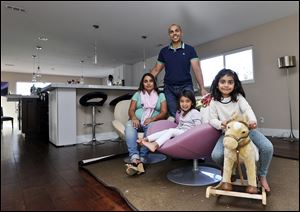
‘Jumbo’ borrowers, conventional mortgages get virtually same rate
6/1/2014
Imran and Aniqa Jaswal and children Arissa, right, and Jayda, pose in their house about 10 minutes from the beach in La Jolla, Calif., a state in which jumbo loans are higher than the national average.
WASHINGTON — For three decades, the U.S. middle class enjoyed a rare financial edge over the wealthy: lower mortgage rates.
Now, even that perk is fading.
Most ordinary homebuyers are paying the same or higher rates than the few who can afford more.
Rates for a conventional 30-year fixed mortgage and “jumbo” mortgages — those above $417,000 in much of the country — were virtually the same, Bankrate reported recently.
This trend reflects the widening wealth gap between the richest Americans and everyone else. Bankers now view jumbo borrowers as safer and shrewder bets even though conventional borrowers put less capital at risk.
Even as the overall U.S. housing recovery has slowed, sales of homes above $1 million have surged in the last year. Price gains have been so great in some areas that middle-class buyers are straining to afford even modest homes. They’re also facing tighter lending rules, larger down-payment requirements, and a shortage of houses for sale.
Used to be, rates for conventional mortgages would be 0.2 to 0.3 of a point below rates on jumbo mortgages. A decade ago, a conventional rate averaged 5.68 percent, a jumbo 5.97 percent. The advantage for middle-class borrowers was possible in part because government-chartered firms guarantee that lenders will be paid on a conventional mortgage even if a borrower defaults. No such guarantee exists for jumbos.
Two factors have caused the spread between conventional and jumbo rates to vanish:
● The government in 2012 began raising the fees it charges lenders for guaranteeing payments on conventional mortgages. Lenders passed along that increase to borrowers in the form of higher rates. The fees are meant to stop home buyers from borrowing more than they can afford — a trend that fueled the 2007 housing bust.
● Bankers say they’ve begun using mortgage rates to woo high-net-worth clients: Attractive rates on jumbos have become a way to secure additional business from those clients — from managing their investments to supplying a broad suite of financial services. What’s more, those borrowers tend to be clustered in neighborhoods that lenders consider more stable.
“Jumbo borrowers represent the holy grail of what financial institutions are pursuing: that much-desired, mass affluent consumer,” said Greg McBride, a senior analyst at Bankrate.
In the first three months of 2014, 37 percent of the money Bank of America Corp. lent for mortgages went to jumbos, compared with 22 percent at the same point last year.
The lower rates are geared for affluent borrowers living in “sweet spots” with strong employment and stable home prices — areas such as metro New York City, Boston, and sections of California, said Matt Vernon, who leads consumer mortgage lending at Bank of America.
“We’re lending where we believe home ownership is sustainable,” Mr. Vernon said.
Wells Fargo & Co. offers jumbos starting at 4.25 percent, about 0.25 point lower than for conventional mortgages. Last month, Wells trumpeted the spillover benefits of increased jumbo lending: A 14 percent year-over-year increase in loans from its separate “wealth, brokerage, and retirement” division.
“Hopefully, it’ll continue to go up,” Wells’ CFO, Timothy Sloan, said about jumbo lending.
Sales of homes exceeding $1 million leapt 7.8 percent during the last 12 months. That contrasted with a 7.5 percent drop in overall home-buying in that time, according to the National Association of Realtors.
Prices have appreciated in areas such as San Francisco, New York, and Washington. Jumbos in these cities are for loans above $625,500, about $200,000 more than the national average.
The median price of a two-bedroom home in San Francisco is $1.02 million, according to the real estate site Trulia. The median for New York City homes: $1.2 million.
Nationwide, just 2 percent of homes fetch prices that large.